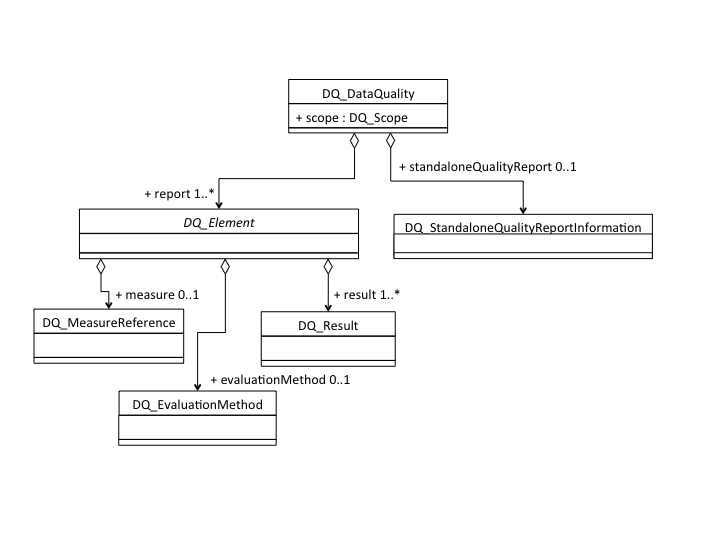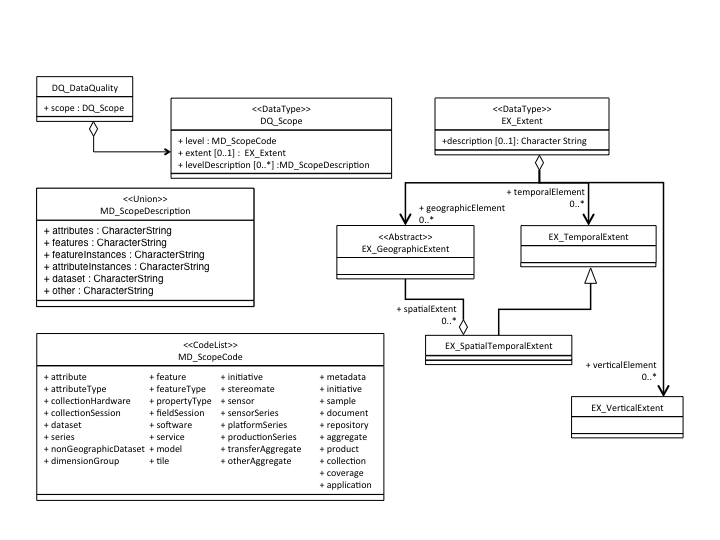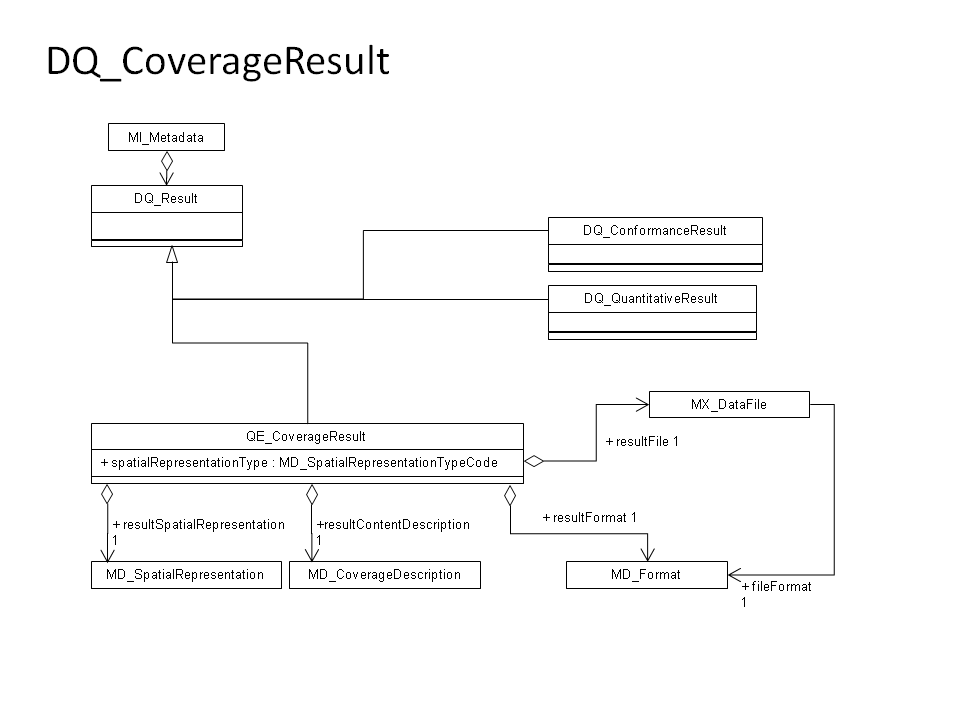Use Case: I need to provide information about the quality of my data and how it was measured.
Overview
A principle goal of metadata is to ensure that the data they describe can be independently understood and used effectively. Data quality measures and reports play a critical role in achieving this goal. Connecting these to the metadata record is clearly important.
The approach to including quality information in ISO 19115 metadata records is similar to the approach used in ECHO and improves on it considerably. It includes the capability to describe quality measures that are used and the techniques used to apply them. Understanding how to take advantage of this flexibility and implementing systems that maximize the value that this capability provides will certainly be a challenge for the environmental data community.
The Data Quality Section of the ISO standard supports flexibility at several levels. The DQ_Data_Quality object (see Figure) includes two sections: scope, and element. A metadata record can have any number of associated DQ_DataQuality objects.
Presentations available that describe the ISO data quality standard and compare it with the DIF and ECHO approaches.
Recommendations
An important initial goal is to connect users to existing literature that includes quality information. This should be done at the collection level using standaloneQualityReports. A complete report includes a description of the scope of the quality information with spatial and temporal extent information, an abstract, and a complete citation.
Conceptual Model
This Figure shows an overview of the data quality information included in the ISO 19157 standard. The elements are:
Scope: quality information can be provided at many different level of detail from an entire series down to specific attributes in particular regions or time periods. The scope attribute lets users know what the current information pertains to.
StandaloneQualityReport: quality information exists in papers and reports that are already part of the scientific literature. Users can find this information using citations included in the metadata record.
Report: quality reports hold the bulk of the structured quality information in the metadata record. They describe the quality measure, how it was applied, and the result of the application.
An overview of the complete data quality standard is also available.
Scope:
The DQ_Scope object enables a complete description of the scope of a data quality report whether it pertains to a complete data series or to a particular temporal and spatial extent for a particular parameter in a dataset.
level:
The level element of the scope provides a general description of the scope using a codelist of standard terms. The level can be used in an initial search of the quality information to answer questions like "what kinds of quality information are available for this collection or granule".
attribute | dimensionGroup | model | aggregate |
attributeType | feature | tile | product |
collectionHardware | featureType | metadata | collection |
collectionSession | propertyType | initiative | coverage |
dataset | fieldSession | sample | application |
series | software | document |
|
nonGeographicDataset | service | repository |
levelDescription:
In some cases, the general description provided by the codelist is not enough. In those cases the levelDescription can be used to provide more detail. For example, the scope code might be "attribute", indicating that the report concerns an attribute of the dataset, and the levelDescription would provide the name(s) of the specific attributes covered, i.e. precipitation rate.
extent:
In some cases, the quality information may apply to a particular spatial and temporal extent of the dataset. This extent can be described at several different levels of detail using the EX_Extent object. The extent should be described quantitatively, if possible, or with a text description if quantitative information is not possible.
StandAlone Report
ISO 19157 recognizes that important data quality information can exist outside of the conceptual framework of the model and that it may be helpful to provide that information as a supplement to the metadata. The standaloneQualityReport was added to enable connections between the metadata and these reports. It includes an abstract (CharacterString) that provides a brief description of the quality report in the metadata record and a the citation (CI_Citation) that provides the reference that a user needs for the complete report.
In many cases quality information is provided on the Web pages. Those can also be referenced as StandAloneReports.
As an example, consider this data quality description from a GCMD metadata record:
Abstract: The fire training-set may also have been biased against savanna and savanna woodland fires since their detection is more difficult than in humid, forest environments with cool background temperatures [Malingreau, 1990]. There may, therefore, be an under-sampling of fires in these warmer background environments.
Citation: Malingreau J.P, 1990, The contribution of remote sensing to the global monitoring of fires in tropical and subtropical ecosystems. In: Fire in Tropical Biota, (J.G. Goldammer , editor), Springer Verlag , Berlin: 337-370.
Report
Quality reports are encapsulated in the 19115 DQ_Element class that includes three kinds of information, the measure, the evaluationMethod and the result. It is expected that an organization uses a standard set of quality measures that are managed centrally and have unique names, descriptions, and identifiers. The nameOfMeasure and measureDescription are included in the metadata record and should help users understand the nature of the measure. The measureIdentification is an identifier that can be used to find a more detailed description of the measure.
The evaluation method provides information on how the quality measure was applied for this report. These methods can also be standardized across an organization. Citations are available to describe the specific proceedure and more complete references.
Finally, the result reports the results of the application of the measure in this specific case. Several types of reports are included in the standard (see below).
DQ_MeasureReference [0..1]
+ measureIdentification: MD_Identifier [0..1]
+ nameOfMeasure: CharacterString [0..*]
+ measureDescription: CharacterString [0..1]
DQ_EvaluationMethod [0..1]
+ dateTime: DateTime [0..*]
+ evaluationMethodDescription: CharacterString [0..1]
+ evaluationProceedure: CI_Citation [0..1]
+ referenceDoc: CI_Citation [0..*]
+ evaluationMethodType: DQ_EvaluationMethodTypeCode [0..1]
DQ_Result [1..*]
+ dateTime: DateTime [0..*]
+ resultScope: DQ_ScopeCode [0..1]
Result Types
The ISO Standard include four types of data quality results in the DQ_Element object.
The first, the DQ_ConformanceResult, describes how the dataset was
tested for conformance to a published standard and whether the dataset
passed the test. The second, the DQ_QuantitativeResult, provides a
mechanism for describing the results of a quantitative quality
evaluation. Finally, the QE_CoverageResult (from ISO 19115-2),
allows a quality result to be expressed as a spatial object.
For example, if a gridded dataset has an associated grid of quality
flags, that quality grid could be described here. Note also that
the coverage results have an associated file and format.
The quality of many datasets varies spatially within the dataset. For example, gridded satellite datasets include grids that provide quality flag values for every pixel. Radiosondes in the atmosphere and profiles in the ocean also can have quality that varies along their paths. In situations like these, the quality information can be described using a spatial feature like a grid or a line. In ISO quality information in spatial features is described using a coverageResult.
The coverageResult includes MD_SpatialRepresentation and MD_CoverageDescriptions that describe the quality coverage. In this case, the MD_CoverageDescription can serve a role that is similar to the role of the measure and evaluationMethod elements in the report.
The MD_CoverageDescription includes a contentType that can currently be image, thematicRepresentation, or physicalMeasurement. The revision of 19115 may add qualityInformation to this codelist and allow multiple contentType values.
The DQ_Descriptive result was introduced in ISO 19157 in order to include simple textual descriptions of data quality in the standard. It is a simple CharacterString.
DQ_ConformanceResult
+ specification : CI_Citation
+ explanation : CharacterString
+ pass : Boolean
Or
DQ_QuantitativeResult
+ valueType [0..1] : RecordType
+ valueUnit : UnitOfMeasure
+ errorStatistic [0..1] : CharacterString
+ value [1..*] : Record
Or
QE_CoverageResult (added in ISO 19115-2, see UML below)
+ spatialRepresentationType: MD_SpatialRepresentationTypeCode, one of vector, grid, textTable, tin, stereoModel, video
+ resultFile: MX_DataFile
+ resultFormat: MD_Format
+ resultSpatialRepresentation: MD_SpatialRepresentation
+ resultContentDescription: MD_CoverageDescription
Or
DQ_DescriptiveResult
+ statement: CharacterString
Implementation (XML)
Implementation (NcML)
Usage
Crosswalks
Notes
Tracking Compliance With Standards
The importance of standards in data integration is well know and broadly acknowledged. It is also well known that compliance tests will be required so that developers can systematically measure compliance with standards that evolve with time. Of course, these tests can only useful to users if the results are available and understandable.
<p>There are two ISO Standard objects that apply to compliance reports. The first is the DQ_DataQuality object. This object associates a DQ_Element with a service, a dataset, or some subset of a dataset described by the DQ_Scope. The DQ_Element references a test and an evaluation procedure that produces a DQ_Result at a particular time. There are three types of DQ_Results, but the DQ_ConformanceResult is the type that is relevant here. It references the specification being tested, explains the meaning of conformance, and gives a Boolean result.
The second ISO object that could be related to conformance testing is the MD_Usage object. This provides a mechanism for incorporating user problems into the metadata for a dataset or service. The object includes a description of the specific usage, the problem encountered (the limitation), the date and the user contact information. In the case of standards compliance, the usage would be attempting to access the dataset or service in a way that is consistent with an advertised standard and the limitation would be finding the dataset to be non-compliant with the advertisement. These problem reports would be available from the archive and, hopefully, would motivate data providers to be careful about advertising services that they could not support.
MD_Usage
+ specificUsage : CharacterString
+ usageDateTime [0..1] : DateTime
+ userDeterminedLimitations [0..1] : CharacterString
+ userContactInfo [1..*] : CI_ResponsibleParty
How might these new types of reports be used? The environmental data community is using more and more standard formats for data files. The conformance test might indicate how well the dataset conforms to those file formats or associated conventions like the Climate Forecast conventions for netCDF.


